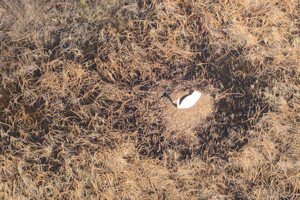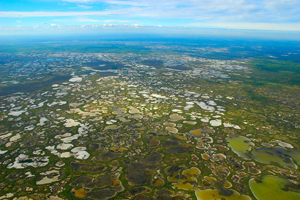
Photo: Parks Canada / Klaus Nigge
A Whooping Crane Mystery
Wood Buffalo National Park
Although there were very few whooping cranes left by the early 1940’s, they were highly visible and easily counted each year at their wintering grounds in and around the Aransas National Wildlife Refuge along the Gulf of Mexico in southern Texas. But what was not known back in the 1940’s and early 1950’s was where they nested. The last known nest had been seen in Saskatchewan in 1926. So every spring the whooping cranes flew north from southern Texas and disappeared. Despite search efforts by U.S. Fish and Wildlife Service and others over the years, the location of their nesting area remained a mystery.

Photo: Parks Canada / John McKinnon
In 1954 a forest fire was burning in the remote northern reaches of Wood Buffalo National Park. As part of a routine fire-fighting operation, a forestry helicopter was flying to the site of the fire. The occupants were pilot Don Landells and forestry officer George Wilson. On the way to the fire they happened to look down and saw a few large white birds which they suspected to be whooping cranes. They reported their observation in time for the region’s biologist, Dr. William (Bill) Fuller, to catch the next helicopter flight out to the scene of the fire. Sure enough, Dr. Fuller was able to confirm that the birds spotted were indeed whooping cranes.
This was exciting news for all the Canadians and Americans involved in whooping crane conservation at the time, but final confirmation of the discovery of the nesting area didn’t occur until a ground survey was done in 1955. And this wasn’t just any old ordinary ground survey. It consisted of two brutal and physically taxing expeditions, with a team led by Robert (Bob) Porter Allen, Ray Stewart of the Canadian Wildlife Service and Bob Stewart of the U.S. Fish and Wildlife Service, paddling and portaging on foot through the most inhospitable wetland terrain imaginable.

Photo: Parks Canada / John McKinnon
The first two ground attempts were unsuccessful in reaching any cranes! Just when they were on the verge of giving up for the year, two of the team members had a chance for another drop-off by helicopter at a different location, and this time – success! Here is a quote from one of the crew : “It has taken 31 days and a lot of grief, but let it be known that at 2 p.m. on this day 23rd of June, we are on the ground with the whooping cranes! We have finally made it!” 1
What is amazing about this story is that when Wood Buffalo National Park was first established in 1922, they had no idea that the whooping cranes were nesting there – the park was originally established to protect another Species at Risk, the wood bison. This amazing stroke of good luck undoubtedly contributed to the whooping cranes’ survival.
1 Janice M. Hughes, Cranes, A Natural History of a Bird in Crisis, Firefly Books Ltd, New York, 2008
History and Ecological Monitoring of Whooping Cranes in Wood Buffalo National Park
Why Endangered?
Back from the Brink of Extinction
- Date modified :